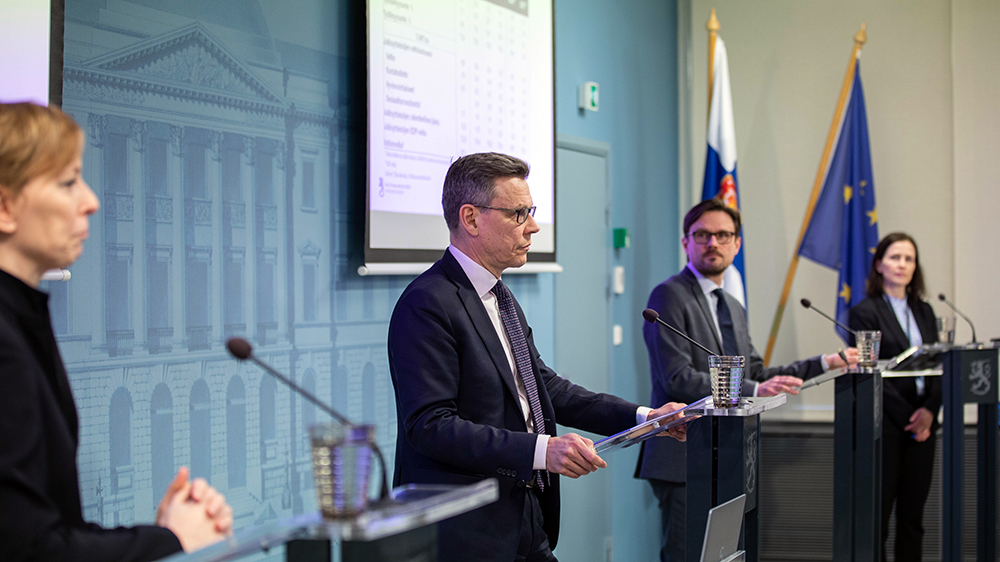Economic Survey
Finland to rebound from recession at the end of the year

The Finnish economy will return to growth at the end of the year following a mild recession, barring new surprises. However, the general government deficit will grow as rising prices begin to be reflected in general government expenditure according to the economic survey published by the Ministry of Finance on 23 March.
Households have reduced their consumption as a result of rapid inflation and rising interest rates. The Finnish economy has been in a mild recession since last autumn. This year, gross domestic product (GDP) is expected to contract by 0.2 per cent, but purchasing power will begin to rise as inflation slows and salaries and wages increase during 2023. The Finnish economy is expected to grow 1.3 per cent in 2024 and 1.6 per cent in 2025.
“The economic outlook in Europe has improved as fears of an energy crisis have subsided. In Finland, the recession will be mild and short. The economy will begin to grow again over the course of the year. Unfortunately, there will be no corresponding relief in general government finances,” says Director General Mikko Spolander.
Expectations for global economic growth have improved as energy prices have fallen and China has succeeded in lifting restrictions imposed due to COVID-19. On the other hand, the rate of inflation has not slowed as quickly as expected, and central banks have raised their key interest rates rapidly. Rising interest rates are slowing economic growth and they have also significantly increased uncertainty on the financial markets over the past few weeks.
Many uncertainty factors in the economy
The forecast is based on the assumption that the impact of Russia’s invasion of Ukraine will remain at the current level. It is difficult to predict what impact new developments in the war would have on the Finnish and European economies.
The surge in interest rates has caused expected problems in the financial and real estate markets. These problems could prove to be worse than expected.
Rising prices and interest rates have caused a fairly large gap in household finances. The impact on household consumption behaviour has been moderate so far thanks to savings accrued during the COVID-19 pandemic. However, consumption could fall more sharply, especially if prices continue to rise more rapidly than expected. A brighter economic outlook and the effect that large pay increases will have on household expectations for their own consumption could provide a positive surprise.
Finnish exports dependent on global market demand
As the growth of world trade picks up, Finland’s exports will also return to growth in 2023 and pick up speed in 2024. Finland’s price competitiveness is in good shape, because the agreed pay settlements did not exceed those of reference countries. In addition, energy prices have risen less in Finland than the euro area average, and favourable expectations for the price and availability of energy will support the price competitiveness of Finnish production.
Uncertainty and higher interest rates will reduce construction in 2023 and 2024. This will be temporary, however, as immigration and migration will maintain demand. The green transition and technological revolution will increase investments in production and R&D, partially thanks to public aid.
Employment to drop from record level
Employment is forecast to drop in 2023 from the current record level. The number of job vacancies is still high, but has already fallen significantly. The number of employed persons will decrease by about 0.5 per cent in 2023, and the unemployment rate will increase to 7 per cent. The drop in the number of employed persons will mainly be caused by pension and layoff arrangements. However, employment will improve again as the economy begins to grow, and the employment rate is expected to rise to 74.2 per cent by 2025.
Improvement of general government finances only temporary
The general government deficit decreased last year to the level preceding the COVID-19 pandemic as a result of rapid growth, high employment and the end of measures taken to combat the COVID-19 pandemic. This year, the deficit will begin to grow again driven by the general economic situation, index adjustments, higher general interest rates and increasing spending on preparedness. The general government deficit will be 2.6 per cent of GDP this year and next year, and it will temporarily climb to over 3 per cent in 2025. The deficit is expected to drop to slightly below 3 per cent in 2026 and 2027.
The general government debt-to-GDP ratio reflects deep deficits and weak economic development. The general government debt-to-GDP ratio began to rise moderately last year, and this growth will accelerate from this year onwards. No halt in the growth of the debt ratio is in sight. The sustainability gap in general government finances will be approximately 3 per cent of GDP at the 2027 level.
From 2024 onwards, the forecast for general government finances is an unchanged policy forecast, which means that it does not account for decisions of the next government. Decisions taken by the next government could have a significant impact on deficits and the debt ratio, in which case the deficit and debt trajectories described in this forecast will not be realised.
Inquiries:
Mikko Spolander, Director General, tel. +358 295 530 006, mikko.spolander(at)gov.fi
Janne Huovari, Senior Ministerial Adviser, tel. +358 295 530 171, janne.huovari(at)gov.fi (real economy)
Jenni Pääkkönen, Senior Ministerial Adviser, tel. +358 295 530 131, jenni.paakkonen(at)gov.fi (general government finances)
